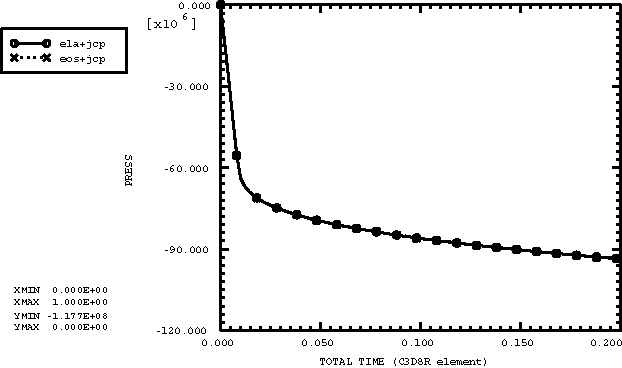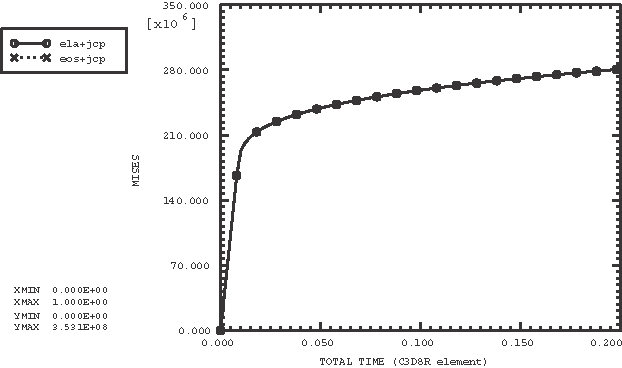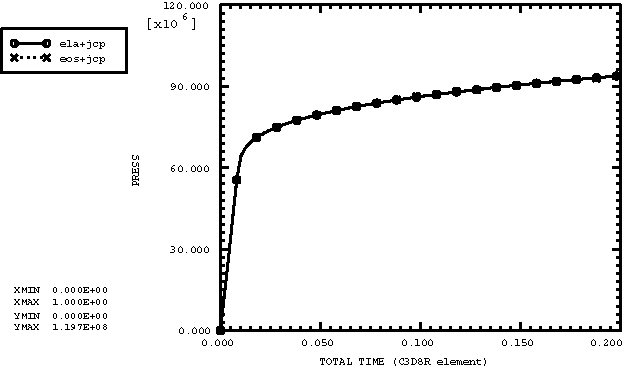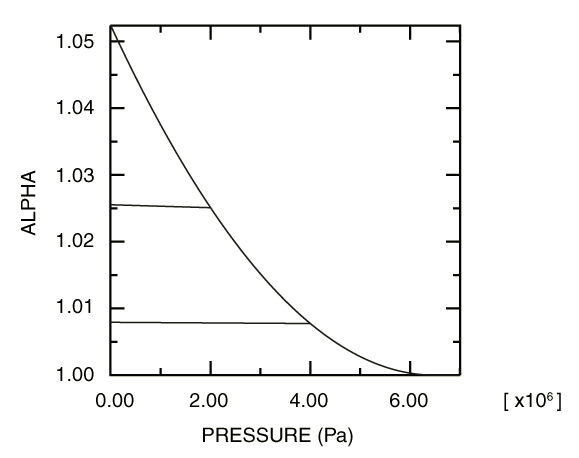Equation of state material | ||
| ||
ProductsAbaqus/Explicit
Linear Us − Up Hugoniot equation of state
Elements tested
C3D8R
CPE4R
Features tested
Linear equation of state (EOS) material model with plasticity.
Problem description
This verification test consists of a list of single-element models that use either C3D8R or CPE4R elements and are run under simple loading conditions (uniaxial tension, uniaxial compression, and simple shear). The purpose of this example is to test the equation of state material model and its combination with the Mises and Johnson-Cook plasticity models. Two parallel sets of models are studied. The first set uses the linear elastic, linear elastic with Mises plastic, and linear elastic with Johnson-Cook plastic materials. The second set uses the linear type of EOS, linear type of EOS with Mises plastic, and linear type of EOS with Johnson-Cook plastic materials.
For linear elasticity the volumetric response is defined by
where K is the bulk modulus of the material. The linear Hugoniot form is
where is the same as the nominal volumetric strain measure, . Thus, setting the parameters 0.0 and 0.0 gives the simple hydrostatic bulk response, which is identical to the elastic volumetric response. The elastic deviatoric response of the material is defined by the shear modulus.
The elastic material properties are Young's modulus = 207 GPa and Poisson's ratio = 0.29. The initial material density, , is 7890 kg/m3. The equivalent properties for the linear type of equation of state material model are = 4563.115 m/s and shear modulus = 80.233 GPa. For models in which plasticity (including both Mises and Johnson-Cook plasticity models) is used, the plastic hardening is chosen to be
where is the yield stress (in units of MPa) and is the equivalent plastic strain.
Results and discussion
The results obtained from the analyses that use the EOS material model match the corresponding results obtained from the analyses that use the linear elasticity model. The comparison of the pressure and Mises stresses obtained with the EOS material model (with Johnson-Cook plastic shear response) and the linear elasticity model (with the same Johnson-Cook plastic shear response) using the C3D8R element under uniaxial tension loading are shown in Figure 1 and Figure 2, respectively. The uniaxial compression comparisons are shown in Figure 3 and Figure 4.
Input files
- eosshrela.inp
Uniaxial tension test.
- eosshrela_pre.inp
Uniaxial compression test.
- eosshrela_shr.inp
Simple shear test.
- eosshrelainit_shr.inp
Simple shear test with nonzero initial conditions for .
Figures




![]()
Tabulated equation of state
Elements tested
C3D8R
CPE4R
Features tested
Tabulated equation of state (EOS) material model with plasticity.
Problem description
This verification test consists of single-element models that use either C3D8R or CPE4R elements and are run under simple loading conditions (uniaxial tension, uniaxial compression, and simple shear). The purpose of this example is to test the tabulated EOS material model and its combination with the Mises and Johnson-Cook plasticity models. Two parallel sets of models are studied. The first set uses the linear elasticity, linear elasticity with Mises plasticity, and linear elasticity with Johnson-Cook plasticity materials. The second set uses the tabulated EOS, tabulated EOS with Mises plasticity, and tabulated EOS with Johnson-Cook plasticity materials.
For linear elasticity the volumetric response is defined by
where K is the bulk modulus of the material. The tabulated EOS is linear in energy and assumes the form
where and are functions of the logarithmic volumetric strain only, with , and is the reference density. Thus, setting the functions and 0.0 gives the simple hydrostatic bulk response, which is identical to the elastic volumetric response. The elastic deviatoric response of the material is defined by the shear modulus.
The elastic material properties are Young's modulus = 207 GPa and Poisson's ratio = 0.29. The initial material density, , is 7890 kg/m3. The properties for the tabular EOS material model are computed using = 164.286 GPa and shear modulus = 80.233 GPa. For models in which plasticity (including both Mises and Johnson-Cook plasticity models) is used, the plastic hardening is chosen to be
where is the yield stress (in units of MPa) and is the equivalent plastic strain.
Results and discussion
The results obtained from the analyses that use the EOS material model match the corresponding results obtained from the analyses that use the linear elasticity model.
Input files
- eostabshrela.inp
Uniaxial tension test.
- eostabshrela_pre.inp
Uniaxial compression test.
- eostabshrela_shr.inp
Simple shear test.
- eostabshrelainit_shr.inp
Simple shear test with nonzero initial conditions for .
![]()
P–α equation of state
Elements tested
C3D8R
CPE4R
Features tested
equation of state (EOS) material model.
Problem description
This verification test consists of single-element models that use either C3D8R or CPE4R elements and are run under simple loading conditions (uniaxial, hydrostatic, and simple shear). The purpose of this example is to test the equation of state material model and its combination with different models for the deviatoric behavior: linear elastic, Newtonian viscous shear, and Mises and Johnson-Cook plasticity; as well as itscombination with different models for the hydrodynamic response of the solid phase: Mie-Grüneisen and tabulated equations of state.
The material properties used for the tests are representative of partially saturated sand. They are summarized below:
Material:
- Solid phase
The solid phase is described by a Mie-Grüneisen equation of state:
2070 kg/m3 1480 m/sec s 1.93 0.880 For models using the tabulated equation of state, the functions and are defined such as to provide similar hydrodynamic behavior as the above Mie-Grüneisen equation of estate.
- Compaction properties
-
600 m/sec () 0.049758 (1.052364) 0.0 MPa 6.5 MPa - Viscous shear behavior
-
5.0E+4 - Elastic shear behavior
-
E 124 MPa 0.3 - Plasticity
For models with plastic shear behavior (either Mises or Johnson-Cook plasticity), the plastic hardening is chosen to be
where is the yield stress (in units of MPa) and is the equivalent plastic strain. The plasticity models are used in combination with linear elastic shear behavior.
Results and discussion
The results obtained from the analyses agree well with exact analytical or approximate solutions. The evolution of the distension with hydrostatic pressure during a cyclic volumetric test is shown in Figure 5.
Input files
- eospalpha_uni.inp
Uniaxial test.
- eospalpha_vol.inp
Cyclic hydrostatic test.
- eospalpha_shr.inp
Simple shear test.
- eospalphainit_shr.inp
Simple shear test with nonzero initial conditions for .
Figures

![]()
Viscous shear behavior
Elements tested
C3D8R
CPE4R
Features tested
Viscosity models for equation of state materials with viscous shear behavior.
Problem description
This verification test consists of single-element models that use either C3D8R or CPE4R elements and are run under simple shear loading conditions. The purpose of this example is to test the different viscosity models for both Newtonian and non-Newtonian fluids. The hydrodynamic response of the material is described by the Mie-Grüneisen equation of state in all cases. Some tests include thermo-rheologically simple temperature-dependent viscosity using the Arrhenius form.
The material properties used for the tests are summarized below:
Material:
- Hydrodynamic properties
The hydrodynamic response described by a Mie-Grüneisen equation of state:
2070 kg/m3 1480 m/sec s 1.93 0.880 - Viscous properties
The properties for each of the tested viscosity models are given below:
- Mat1:
Newtonian viscosity:
1 MPa sec - Mat2:
Power Law viscosity:
2.173 MPa (sec)n 0.392 1 MPa sec 0.1 MPa sec - Mat3:
Carreau-Yasuda viscosity:
1 MPa sec 0.1 MPa sec 0.11 sec 0.392 0.644 - Mat4:
Cross viscosity:
1 MPa sec 0.1 MPa sec 0.11 sec 0.392 - Mat5:
Herschel-Bulkley viscosity:
1 MPa sec 3.59 MPa 2.173 MPa (sec)n 0.392 - Mat6:
Ellis-Meter viscosity:
1 MPa sec 0.1 MPa sec 5.665 MPa 0.392 - Mat7:
Powell-Eyring viscosity:
1 MPa sec 0.1 MPa sec 0.11 sec - Mat8:
Tabular viscosity:
(MPa sec) (sec-1) 1.00000 0.0 0.83383 1.0 0.76532 2.0 0.71776 3.0 0.68112 4.0 0.65134 5.0 0.62631 6.0 0.60477 7.0 0.58593 8.0 0.56921 9.0 0.55422 10.0 0.54066 11.0 0.52830 12.0 0.51697 13.0 0.50652 14.0 0.49684 15.0 - Mat9:
User-defined Cross viscosity. The viscosity is expressed as
1 MPa sec 0.11 sec 0.392 - TRS properties
Arrhenius form:
109100 joule/mole 308 kelvin 0 kelvin 8.31434 joule/(mole kelvin)
Results and discussion
The results obtained from the analyses agree well with exact analytical or approximate solutions.
Input files
- eosshrvisc.inp
Simple shear test.
- eosshrvisctrs.inp
Material with Arrhenius TRS properties. Simple shear test.
- eosshrvisc.f
User subroutine VUVISCOSITY for the user-defined Cross viscosity model used in eosshrvisc.inp and eosshrvisctrs.inp.
![]()
Pressure-dependent shear plasticity
Elements tested
C3D8R
CPE4R
CAX4R
Features tested
Equation of state (EOS) material model with pressure-dependent (Drucker-Prager) shear plasticity.
Problem description
This verification test consists of single-element models that use either C3D8R, CPE4R, or CAX4R elements and are run under simple loading conditions (uniaxial tension, uniaxial compression, and simple shear). The purpose of this example is to test the combination of EOS models for the volumetric response of the material with the extended Drucker-Prager pressure-dependent plasticity models for the shear response. Some of the models also include Johnson-Cook strain-rate dependence in the plasticity definition.
Results and discussion
The results agree well with exact analytical or approximate solutions.
Input files
- eosjcratedpexpuni3d.inp
Uniaxial tension test, Johnson-Cook strain-rate dependence, Drucker-Prager plasticity with exponent form shear criterion, C3D8R element.
- eosjcratedpexpunicpe.inp
Uniaxial tension test, Johnson-Cook strain-rate dependence, Drucker-Prager plasticity with exponent form shear criterion, CPE4R element.
- eosjcratedpexpuniaxi.inp
Uniaxial tension test, Johnson-Cook strain-rate dependence, Drucker-Prager plasticity with exponent form shear criterion, CAX4R element.
- eosjcratedphypuni3d.inp
Uniaxial tension test, Johnson-Cook strain-rate dependence, Drucker-Prager plasticity with hyperbolic shear criterion, C3D8R element.
- eosjcratedphypunicpe.inp
Uniaxial tension test, Johnson-Cook strain-rate dependence, Drucker-Prager plasticity with hyperbolic shear criterion, CPE4R element.
- eosjcratedphypuniaxi.inp
Uniaxial tension test, Johnson-Cook strain-rate dependence, Drucker-Prager plasticity with hyperbolic shear criterion, CAX4R element.
- eosdruckerprager.inp
Uniaxial tension test, C3D8R and CPE4R elements.
- eosdruckerprager_pre.inp
Uniaxial compression test, C3D8R and CPE4R elements.
- eosdruckerprager_shr.inp
Simple shear test, C3D8R and CPE4R elements.
![]()
User-defined equation of state
Elements tested
C3D8R
CPE4R
Features tested
User-defined equation of state (EOS) material model with plasticity.
Problem description
This verification test consists of single-element models that use either C3D8R or CPE4R elements and are run under simple loading conditions (uniaxial tension, uniaxial compression, and simple shear). The purpose of this example is to test the user-defined EOS material model (user subroutine VUEOS) and its combination with the Mises and Johnson-Cook plasticity models. Two parallel sets of models are studied. The first set uses the linear elasticity, linear elasticity with Mises plasticity, and linear elasticity with Johnson-Cook plasticity materials. The second set uses the user-defined EOS, user-defined EOS with Mises plasticity, and user-defined EOS with Johnson-Cook plasticity materials.
For linear elasticity the volumetric response is defined by
where K is the bulk modulus of the material. To obtain the same elastic volumetric response with the user-defined EOS, the pressure update inside user subroutine VUEOS is
where is the reference density. The user subroutine needs to return the derivative of pressure with respect to density, , which is needed for the the evaluation of the effective moduli of the material that enters the stable time calculation. User subroutine VUEOS also returns the derivative of pressure with respect to the energy, , which is usually needed to solve the nonlinear pressure-energy dependency using the Newton method. In the case considered here, these quantities are
The elastic deviatoric response of an equation of state material can be defined by using the ELASTIC, TYPE=SHEAR option.
The elastic material properties are Young's modulus = 207 GPa and Poisson's ratio = 0.29. The initial material density, , is 7890 kg/m3. The properties for the tabular EOS material model are computed using = 164.286 GPa and shear modulus = 80.233 GPa. For models in which plasticity is used (including both Mises and Johnson-Cook plasticity models), the plastic hardening is chosen to be
where is the yield stress (in units of MPa) and is the equivalent plastic strain.
Results and discussion
The results obtained from the analyses that use the EOS material model match the corresponding results obtained from the analyses that use the linear elasticity model.
Input files
- eosusershrela.inp
Uniaxial tension test.
- eosusershrela_pre.inp
Uniaxial compression test.
- eosusershrela_shr.inp
Simple shear test.
- eosusershrelainit_shr.inp
Simple shear test with nonzero initial conditions for .
- vueos_tab.f
User subroutine VUEOS used in the input files listed above.